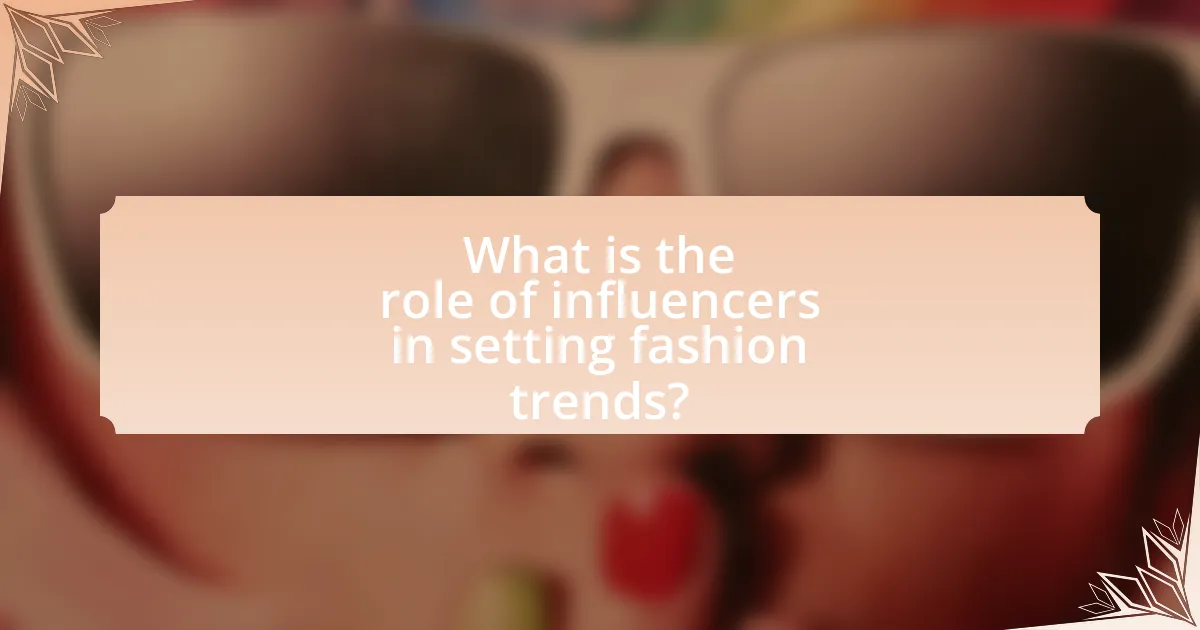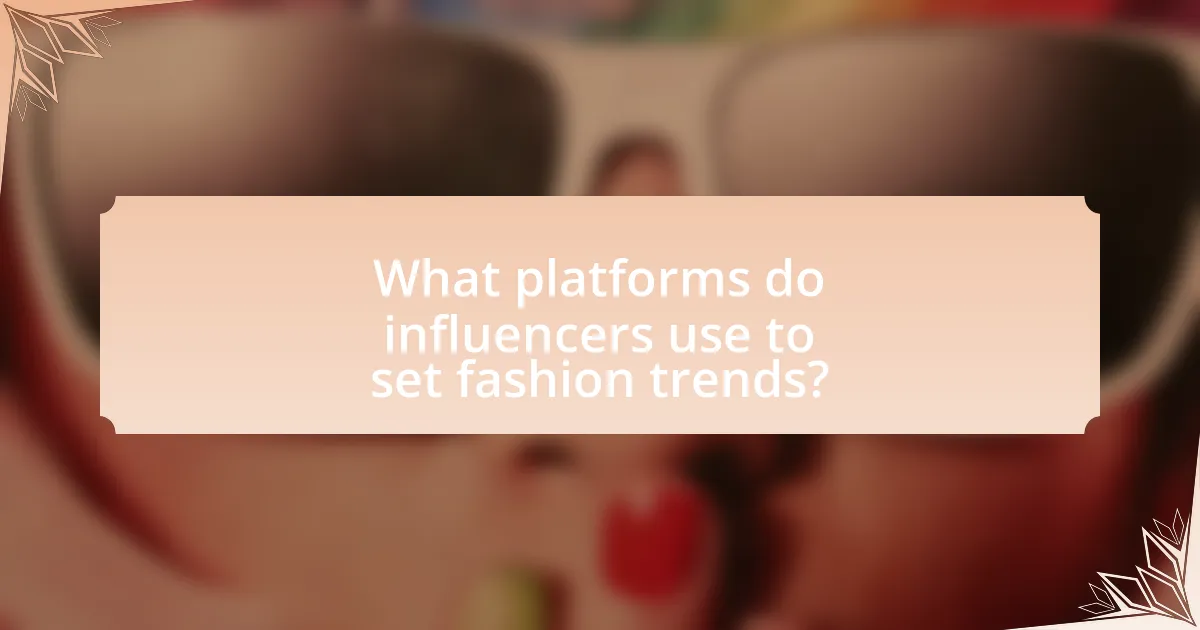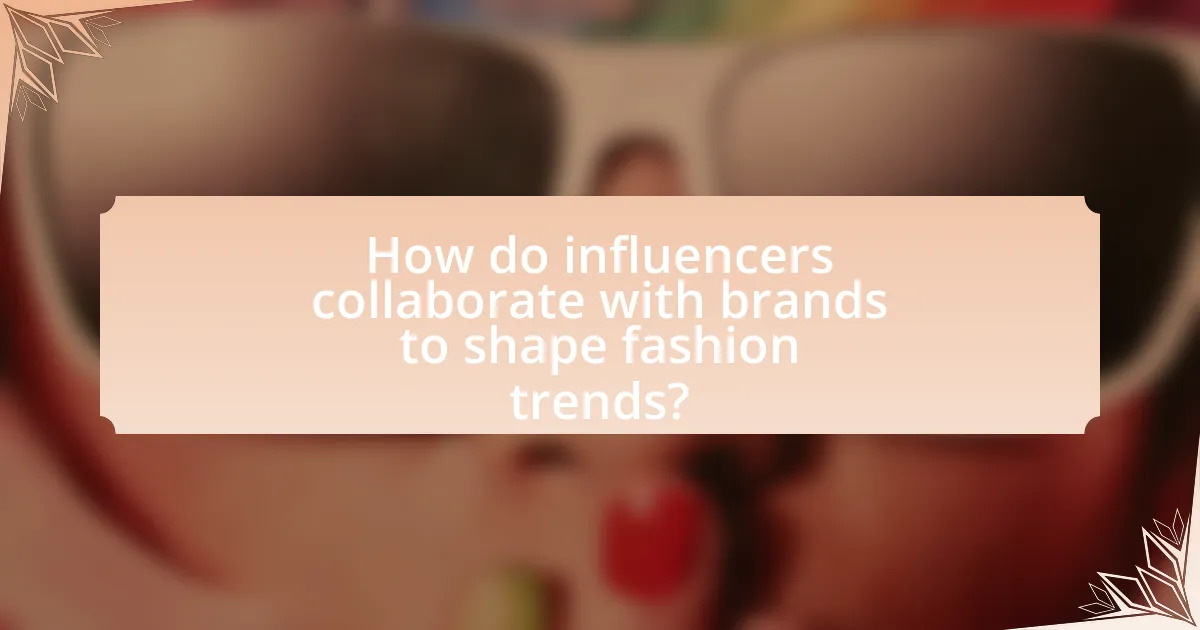The article examines the significant role of influencers in setting fashion trends, highlighting their impact on consumer behavior and brand perceptions through social media platforms. It discusses how influencers shape trends by leveraging their credibility and relatability, with research indicating that a substantial percentage of consumers rely on their recommendations for fashion purchases. The article also explores the psychological factors that enhance influencer effectiveness, the characteristics of successful fashion influencers, and the various collaboration types between influencers and brands. Additionally, it analyzes the influence of platforms like Instagram and TikTok in trend evolution and the strategies influencers use to maintain authenticity while engaging their audience.

What is the role of influencers in setting fashion trends?
Influencers play a crucial role in setting fashion trends by leveraging their social media platforms to showcase styles and brands, thereby shaping consumer preferences. Their ability to reach large audiences allows them to introduce new fashion concepts and products, often leading to viral trends. For instance, a study by the Fashion Institute of Technology found that 70% of millennials are influenced by social media when making fashion purchases, highlighting the significant impact influencers have on consumer behavior.
How do influencers impact consumer behavior in fashion?
Influencers significantly impact consumer behavior in fashion by shaping trends and driving purchasing decisions. Their ability to create aspirational lifestyles and showcase products through social media platforms leads to increased brand visibility and consumer engagement. Research indicates that 49% of consumers rely on influencer recommendations when making fashion purchases, highlighting their persuasive power. Additionally, influencers often foster a sense of community and trust, which enhances consumer loyalty and encourages followers to emulate their style choices. This dynamic illustrates how influencers not only promote products but also influence the overall fashion landscape.
What psychological factors make influencers effective in fashion marketing?
Influencers are effective in fashion marketing primarily due to their ability to establish trust and relatability with their audience. This trust is rooted in social proof, where followers perceive influencers as credible sources of information, leading to increased likelihood of purchasing decisions. Research indicates that 70% of teenagers trust influencers more than traditional celebrities, highlighting the psychological impact of perceived authenticity and relatability. Additionally, influencers leverage the principle of scarcity by promoting limited-edition items, which creates urgency and drives consumer behavior. This combination of trust, relatability, and urgency effectively influences fashion marketing outcomes.
How do influencers shape brand perceptions among consumers?
Influencers shape brand perceptions among consumers by leveraging their credibility and relatability to create a connection between the brand and the audience. This connection often leads to increased trust and loyalty towards the brand, as consumers tend to view influencers as authentic sources of information. Research indicates that 49% of consumers depend on influencer recommendations when making purchasing decisions, highlighting the significant impact influencers have on consumer behavior. Additionally, influencers often curate content that aligns with their personal brand, which can enhance the perceived value and desirability of the products they endorse, further shaping consumer perceptions.
Why are influencers considered trendsetters in the fashion industry?
Influencers are considered trendsetters in the fashion industry because they possess the ability to shape consumer preferences and behaviors through their extensive reach and engagement on social media platforms. Their curated content often showcases the latest styles, which can lead to rapid adoption by their followers. According to a 2021 study by the Digital Marketing Institute, 49% of consumers rely on influencer recommendations for their purchasing decisions, highlighting the significant impact influencers have on fashion trends. This influence is further amplified by their authentic connection with audiences, making their endorsements more relatable and persuasive compared to traditional advertising methods.
What characteristics define a successful fashion influencer?
A successful fashion influencer is defined by their authenticity, strong personal brand, and ability to engage with their audience. Authenticity allows influencers to build trust, as followers are more likely to connect with someone who presents a genuine persona. A strong personal brand differentiates them in a crowded market, showcasing a unique style or perspective that resonates with their target audience. Engagement is crucial; successful influencers actively interact with their followers through comments, stories, and live sessions, fostering a sense of community. According to a study by the Digital Marketing Institute, 70% of consumers are more likely to purchase from a brand recommended by an influencer they trust, highlighting the importance of these characteristics in driving influence and sales.
How do influencers curate their personal brands to influence fashion trends?
Influencers curate their personal brands to influence fashion trends by strategically selecting and showcasing specific styles, aesthetics, and collaborations that resonate with their audience. They often utilize social media platforms to present a cohesive visual identity, which includes consistent color palettes, fashion choices, and lifestyle elements that align with current trends. For instance, a study by the Fashion Institute of Technology found that 70% of consumers are influenced by social media when making fashion purchases, highlighting the significant impact influencers have on consumer behavior. By engaging with their followers through authentic storytelling and interactive content, influencers effectively shape perceptions of fashion trends and drive consumer interest.

What platforms do influencers use to set fashion trends?
Influencers primarily use social media platforms such as Instagram, TikTok, and Pinterest to set fashion trends. Instagram, with its visual-centric approach, allows influencers to showcase outfits and styles to a vast audience, making it a key platform for trendsetting. TikTok’s short-form video format enables influencers to create engaging content that can quickly go viral, influencing fashion choices among younger demographics. Pinterest serves as a visual discovery tool where influencers can curate boards that inspire fashion trends, driving traffic to brands and styles they promote. These platforms collectively enable influencers to reach millions, shaping consumer preferences and trends in the fashion industry.
How does Instagram contribute to fashion trendsetting by influencers?
Instagram significantly contributes to fashion trendsetting by influencers through its visual-centric platform that allows influencers to showcase their style and reach a vast audience. The platform’s algorithm promotes engaging content, enabling influencers to gain visibility and establish themselves as trendsetters. For instance, a study by the Fashion Institute of Technology found that 70% of teenagers trust influencers more than traditional celebrities, highlighting the impact of influencer marketing on consumer behavior. Additionally, Instagram’s features, such as Stories and Reels, facilitate real-time engagement and trend dissemination, further solidifying influencers’ roles in shaping fashion trends.
What features of Instagram enhance influencer engagement in fashion?
Instagram’s features that enhance influencer engagement in fashion include Stories, IGTV, Reels, and shopping capabilities. Stories allow influencers to share ephemeral content, fostering a sense of immediacy and connection with their audience, which can lead to higher engagement rates. IGTV provides a platform for longer-form content, enabling influencers to showcase fashion tutorials or behind-the-scenes looks, thus deepening viewer engagement. Reels, with their short, engaging video format, capitalize on trends and encourage user interaction through challenges and collaborations. Additionally, Instagram’s shopping features enable influencers to tag products directly in their posts, streamlining the purchasing process for followers and driving sales. According to a 2021 report by Hootsuite, 70% of Instagram users have used the platform to discover new products, highlighting the effectiveness of these features in enhancing influencer engagement in the fashion industry.
How do Instagram algorithms affect the visibility of fashion trends?
Instagram algorithms significantly influence the visibility of fashion trends by prioritizing content based on user engagement and relevance. The algorithms analyze user interactions, such as likes, comments, and shares, to determine which posts are shown more prominently in users’ feeds. This means that fashion trends that receive higher engagement are more likely to be seen by a larger audience, thereby amplifying their visibility. For instance, a study by Hootsuite found that posts with high engagement rates can reach up to 50% more users than those with lower engagement, demonstrating the direct correlation between algorithmic prioritization and trend visibility.
What role does TikTok play in the evolution of fashion trends?
TikTok significantly influences the evolution of fashion trends by providing a platform for rapid content sharing and viral challenges that showcase new styles. The app’s algorithm promotes user-generated content, allowing fashion influencers and everyday users to reach large audiences quickly, which accelerates the adoption of emerging trends. For instance, the #TikTokFashion hashtag has garnered billions of views, highlighting how users engage with and disseminate fashion ideas. This phenomenon has led to the rise of micro-trends, where specific styles can gain popularity overnight, demonstrating TikTok’s role as a catalyst in shaping contemporary fashion.
How do TikTok challenges influence fashion choices among users?
TikTok challenges significantly influence fashion choices among users by promoting viral trends that encourage mass participation and imitation. These challenges often showcase specific clothing items or styles, leading to increased visibility and desirability of those fashion elements. For instance, a study by the Journal of Fashion Marketing and Management found that 60% of TikTok users reported changing their fashion preferences based on trends they encountered on the platform. This demonstrates how the interactive nature of TikTok challenges fosters a community-driven approach to fashion, where users feel compelled to adopt and share similar styles, thereby shaping broader fashion trends.
What is the impact of viral trends on traditional fashion cycles?
Viral trends significantly accelerate the pace of traditional fashion cycles by introducing rapid shifts in consumer preferences and styles. Traditional fashion cycles typically operate on a seasonal basis, with designers showcasing collections months in advance. However, viral trends, often propagated through social media platforms, can emerge overnight and gain widespread popularity, leading to immediate demand for specific styles or items. For instance, the rise of TikTok has led to phenomena like the “cottagecore” aesthetic, which quickly influenced mainstream fashion retailers to adapt their offerings to meet this new consumer interest. This shift disrupts the established timeline of fashion cycles, forcing brands to respond more swiftly to changing trends, thereby blurring the lines between seasonal collections and real-time consumer engagement.

How do influencers collaborate with brands to shape fashion trends?
Influencers collaborate with brands to shape fashion trends by leveraging their social media platforms to promote products and styles, thereby influencing consumer behavior. This collaboration often involves sponsored posts, product placements, and exclusive partnerships, where influencers showcase the brand’s offerings to their followers. For instance, a study by the Digital Marketing Institute found that 49% of consumers depend on influencer recommendations when making purchase decisions, highlighting the significant impact influencers have on shaping trends. Additionally, brands often engage influencers to co-create collections or campaigns, ensuring that the products resonate with the influencer’s audience and align with current fashion movements.
What types of collaborations exist between influencers and fashion brands?
Collaborations between influencers and fashion brands primarily include sponsored posts, product collaborations, affiliate marketing, and brand ambassadorships. Sponsored posts involve influencers promoting a brand’s products through their social media channels for compensation, which is a common practice in influencer marketing. Product collaborations occur when influencers co-create a fashion line or specific items with a brand, leveraging their unique style and audience appeal. Affiliate marketing allows influencers to earn commissions by promoting products and sharing unique links, driving sales for the brand. Brand ambassadorships establish long-term partnerships where influencers consistently represent and promote a brand, enhancing brand loyalty and visibility. These collaboration types are essential in shaping consumer perceptions and trends in the fashion industry.
How do sponsored posts differ from organic influencer content?
Sponsored posts are paid advertisements created by influencers to promote a brand or product, while organic influencer content is created without financial compensation, reflecting the influencer’s genuine interest or experience with the brand. Sponsored posts typically include clear disclosures, such as hashtags like #ad or #sponsored, indicating a commercial relationship, whereas organic content is often more subtle and authentic, showcasing the influencer’s personal style or preferences without direct payment. This distinction is crucial as it affects audience perception; studies show that consumers often trust organic content more, viewing it as more authentic and relatable compared to sponsored posts, which can be perceived as less genuine.
What are the benefits of influencer partnerships for fashion brands?
Influencer partnerships provide significant benefits for fashion brands, including increased brand awareness, enhanced credibility, and improved sales. By collaborating with influencers who have established trust and a loyal following, fashion brands can effectively reach targeted audiences. For instance, a study by the Digital Marketing Institute found that 49% of consumers depend on influencer recommendations when making purchasing decisions. Additionally, influencer marketing can yield an average return on investment of $5.78 for every dollar spent, according to a report by Influencer Marketing Hub. This demonstrates that influencer partnerships not only elevate brand visibility but also drive consumer engagement and conversion rates.
How do influencers maintain authenticity while promoting fashion trends?
Influencers maintain authenticity while promoting fashion trends by curating content that aligns with their personal style and values. They often engage with their audience through transparent communication, sharing their genuine opinions about products and brands. For instance, a study by the University of Southern California found that 70% of consumers trust influencers who share personal stories related to the products they endorse, reinforcing the importance of relatability. Additionally, influencers frequently collaborate with brands that resonate with their established identity, ensuring that their promotions feel organic rather than forced. This strategic alignment helps them preserve credibility and foster trust among their followers.
What strategies do influencers use to stay true to their personal style?
Influencers use several strategies to stay true to their personal style, including curating a consistent aesthetic, engaging with their audience authentically, and selecting brands that align with their values. By maintaining a cohesive visual identity across platforms, influencers reinforce their unique style, making it recognizable to followers. Authentic engagement, such as sharing personal stories and experiences, fosters a genuine connection with their audience, which in turn supports their personal brand. Additionally, collaborating with brands that reflect their personal values ensures that their endorsements feel authentic and resonate with their established style. These strategies collectively help influencers remain true to their personal style while effectively influencing fashion trends.
How does authenticity affect follower trust and engagement?
Authenticity significantly enhances follower trust and engagement by fostering a genuine connection between influencers and their audience. When influencers present themselves authentically, they are perceived as more relatable and trustworthy, which encourages followers to engage more actively with their content. Research indicates that 86% of consumers consider authenticity important when deciding which brands to support, highlighting the direct correlation between perceived authenticity and follower loyalty. This trust translates into higher engagement rates, as followers are more likely to interact with content that resonates with their values and beliefs.
What are the best practices for influencers in setting fashion trends?
Influencers can effectively set fashion trends by consistently showcasing unique styles, engaging authentically with their audience, and collaborating with brands that align with their personal aesthetic. Consistency in posting and maintaining a distinct visual identity helps influencers establish themselves as trendsetters. Engaging authentically fosters trust and encourages followers to adopt the styles presented. Collaborations with reputable brands can amplify their reach and credibility, as seen with influencers like Chiara Ferragni, who has successfully partnered with major fashion houses, thereby influencing consumer behavior and trend adoption.
How can influencers effectively engage their audience in fashion discussions?
Influencers can effectively engage their audience in fashion discussions by utilizing interactive content such as polls, Q&A sessions, and live streams. This approach fosters real-time communication and encourages audience participation, which is crucial for building a community around fashion topics. For instance, a study by the Digital Marketing Institute found that 70% of consumers feel more connected to brands when they engage with them through interactive content. By incorporating these methods, influencers not only enhance audience engagement but also create a dynamic platform for sharing fashion insights and trends.
What tips can influencers follow to remain relevant in the fast-paced fashion industry?
Influencers can remain relevant in the fast-paced fashion industry by consistently engaging with their audience and adapting to emerging trends. Regularly posting authentic content that reflects current fashion movements helps maintain audience interest. Additionally, collaborating with brands that align with their personal style and values can enhance credibility and visibility. Staying informed about industry changes through fashion shows, social media, and trend reports allows influencers to anticipate shifts and adjust their content accordingly. For instance, a study by the Fashion Institute of Technology highlights that influencers who adapt their strategies based on audience feedback and market trends see a 30% increase in engagement rates.